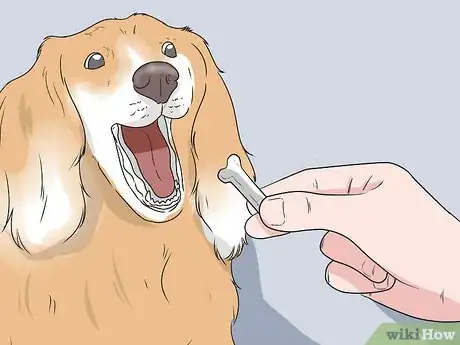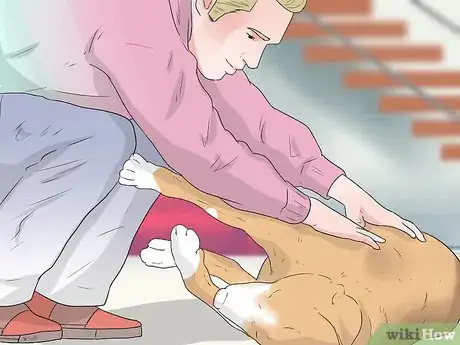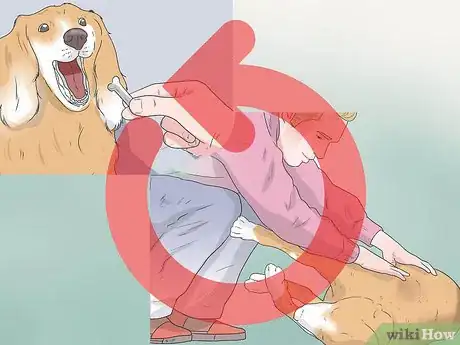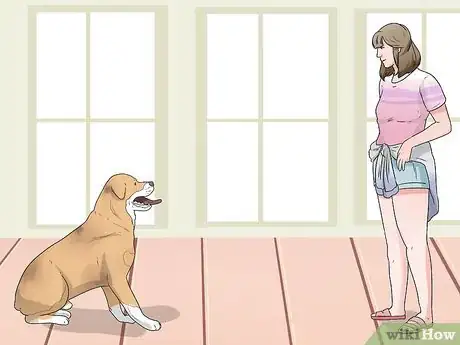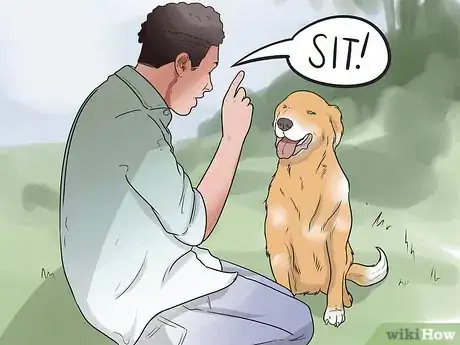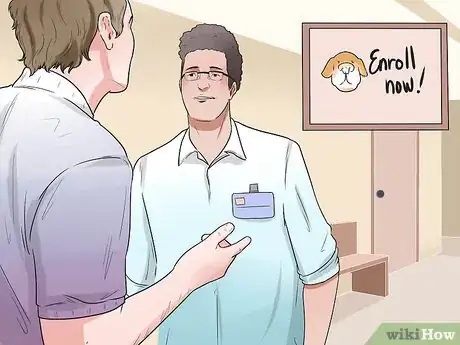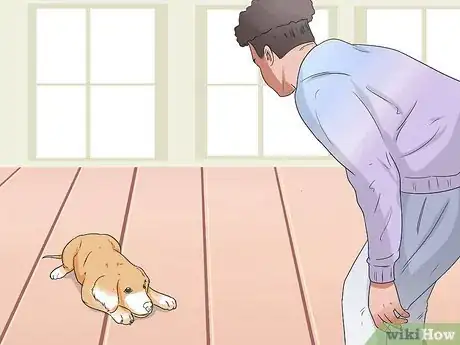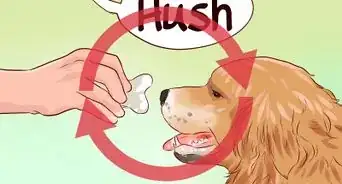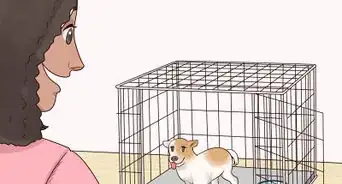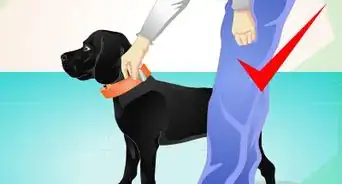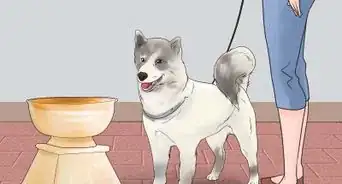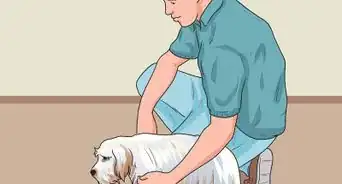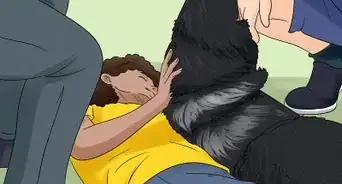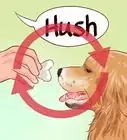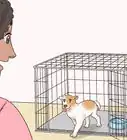This article was co-authored by Ty Brown. Ty Brown is a Dog Behaviorist and Trainer and the Owner of Ty the Dog Guy, a business that provides dog training through digital resources (podcasts, web series, and online courses) along with in-person dog training. Ty has over 17 years of experience in dog training and specializes in both mitigating unruly pet behavior and service dog training. Ty has been awarded the "Best of State Award" for dog training in Utah ten times and his work has been featured in ABC, NBC, CBS, Spike TV, and Entrepreneur Magazine.
There are 8 references cited in this article, which can be found at the bottom of the page.
This article has been viewed 52,105 times.
Fortunately, most dogs want to please their owners, making training easy. However, certain breeds and dogs can be quite challenging (and frustrating) to train. For these dogs, patience and maintaining a happy attitude are key. Short, frequent training sessions will help you train a stubborn dog.
Steps
Giving the Dog Positive Reinforcement
-
1Reward the dog with a highly desirable treat when it behaves. Give your dog the treat as soon as you see the positive behavior. It's helpful to use a clicker to train your dog. That way, you can click the clicker when your dog behaves correctly, then give it a treat. This gives you a little bit of time to get the treat ready, while still reinforcing the good behavior you want to see from your dog.[1]
- Timing is very important when it comes to training your dog. It's important to click the clicker or give your dog its treat immediately after the good behavior.
- Make sure the treat is something your dog loves. The most common reward is a treat. Try boiled chicken, string cheese, or chicken hot dogs. You could try a bone or dog treat. You want to reward the dog when it responds to your command and behaves. If the dog ignores or rejects your command, no treat.[2]
- If treats are the preferred item, keep them handy so that you can practice throughout the day, such as anytime you get up for a drink/snack or bathroom break.[3]
- You could toss the treat on the ground so the dog has to get up. Then, wait again until the dog chooses to sit, without any encouragement from you. When the dog does, say, "Yes!" in a happy tone, and deliver a super yummy treat. Repeat this 5 or 6 times.
-
2Try using other positive reinforcements instead of treats. Sometimes a dog is not food driven, so consider whether they are into a ball or a tug toy. Other dogs just love attention. You have to figure out what makes your dog happiest, and then use that as their reward.[4]
- Praise is simply a happy, excited voice and gentle touching. This is the cheapest and easiest reward to offer. You could also use a favorite toy as a reward.[5]
- Touch is another great way to reward a dog. Some dogs respond to being petted or their tummies being rubbed. A brisk 10-minute walk can also be a reward if you are able.
Advertisement -
3Repeat training exercises and commands several times in a day. Be very consistent and repetitive. A solid training program takes a minimum of two years of consistent and organized training.
- You will get as much out of your dog as you put into them. If we say our dogs are "stubborn," we are basically making excuses for not learning how to teach our dogs to understand us.
- Ensure everyone around the dog has the same rules and expectations. Everyone in the household should use the same commands for tricks and set out the same limitations. Don't feel sorry for the dog and violate your own rules at times. The dog will learn the wrong lesson.
Letting the Dog Know You’re In Charge
-
1Be assertive with the dog to establish control, but don’t use force. Convincing the dog that you are in control is vital. This shouldn't be done through cruelty, such as beating or hitting the dog.
- It is done by simply stepping in front of the dog, and making it back up and allowing you to go through a doorway first. It is done by taking a bone/toy away from the dog when you want it. Don't play when your dog wants you to; play when you want to, and stop when you want to.
- Use your voice, but understand that dogs respond to tone and emotion as much as words.[6] Change the tone of your voice appropriately - for example, lighthearted and higher to say well done, and serious and deeper for commands and when the dog isn't doing as it should. A firm no or nope is as important as praising a puppy or dog for doing things properly.
-
2Train your dog while walking him or her. You can establish control with a dog while walking the dog with a leash. Don't let the dog take the lead or go off leash.
- Whenever you train a dog, she or he is training you. People running after their dog on a long leash is an example of a well-trained human to a dog. It is a game of patience, and the more patient one wins, and the less patient one loses. A tired dog, though, might be easier to train at home when you get back.
-
3Start with the easiest commands. The easiest command to teach is "sit." Once they learn a command, the others will come a little easier. They will start to realize that will get praise and a treat if they can figure out what you are trying to tell them.
- Use audible and visual commands. Say "sit" and make some sort of hand gesture. Make sure to do the same thing every time or you will confuse the dog and make the process longer.
- In the beginning, reward the dog if it gets close to sitting. Eventually you can work your way to a full sit. However, once they execute a full sit, you should not reward them for a half-hearted sit.
- Think of ways to break up a trick or command to make it easier for the dog to learn. Don't make the dog roll over for the first trick or it will be too complicated.
-
4Be patient, and teach your dog patience. Teach the dog to wait for the reward. Don't let them sit for a split-second, and then bounce around like a hooligan. The reward only occurs while they are calm and obeying.
- Do not show emotion or frustration, as the dog will pick up on this, and it won’t help. Keep calm and remember your dog is doing their best. Show the dog love.[7]
- Dogs will never obey an unstable person. If you are scared, your dog might get dominant towards you and, if you are excited, he or she will not take you seriously. If you are aggressive, he or she will be confused about what to do and won't follow this kind of energy.
Using Other Dog Training Techniques
-
1Train the dog in a place with low distraction. What is competing for your dog's attention? Is it a squirrel? Is it a vacuum cleaner? A particular tempting pile to roll in? When you are first introducing a behavior, start in a familiar, low distraction place, like your house.
- Keep your lessons short (5 minutes or less). Your dog has a small brain and won’t be able to concentrate for very long.
- Never train more than one dog at a time. Dogs are easily distracted, and another dog in the area doesn't help your efforts. Dogs always display different behavior when they are around other dogs (whether they are a familiar dog to them or not). They might end up playing with the other dog more than they are listening to you.
-
2Enroll the dog in obedience classes. Another option (if available) is enrolling the dog in “fun” classes, where dog training experts will help you with a stubborn dog.[8]
- You could also hire a dog trainer to come to your home. Check with your local veterinarian for references.
- Try using a clicker with the dog. You need to associate your clicker with a treat, so your dog knows that a reward is waiting when you use the clicker and say a command.
-
3Try to figure out why the dog is remaining stubborn. Maybe the dog feels like he is being bullied and has shut himself away from any input (this is especially common in sensitive dogs, and dog breeds that are usually sensitive).
- Maybe the dog is slower by nature (some dogs are just not as active as some other dogs; if you have a dog that usually moves slowly, don’t expect him to do fast tricks.)
- Consider whether the dog is lazy or sick (dogs, like people, will be less motivated to do things on hot days, for example, or when they are not feeling well).
- Be honest about whether the dog simply does not understand what the owner wants (some things, like sentences, can seem very clear to humans but are not understandable to a dog despite a dog's best intentions). Maybe there is nothing in it for the dog (dogs, like humans, do things because there is something to be gained from it; dogs expect less - a treat, ball or a pat is to them what a whole salary is to a human).
Expert Q&A
-
QuestionWhat do you do with a stubborn dog?
 Ty BrownTy Brown is a Dog Behaviorist and Trainer and the Owner of Ty the Dog Guy, a business that provides dog training through digital resources (podcasts, web series, and online courses) along with in-person dog training. Ty has over 17 years of experience in dog training and specializes in both mitigating unruly pet behavior and service dog training. Ty has been awarded the "Best of State Award" for dog training in Utah ten times and his work has been featured in ABC, NBC, CBS, Spike TV, and Entrepreneur Magazine.
Ty BrownTy Brown is a Dog Behaviorist and Trainer and the Owner of Ty the Dog Guy, a business that provides dog training through digital resources (podcasts, web series, and online courses) along with in-person dog training. Ty has over 17 years of experience in dog training and specializes in both mitigating unruly pet behavior and service dog training. Ty has been awarded the "Best of State Award" for dog training in Utah ten times and his work has been featured in ABC, NBC, CBS, Spike TV, and Entrepreneur Magazine.
Dog Trainer Take the dog for long walks. Make sure you are either walking ahead of the dog or side-to-side. A stubborn dog always thinks he is the leader, and not you. If your dog does not follow your commands, try responding with a brief tug on their leash and a firm "no."
Take the dog for long walks. Make sure you are either walking ahead of the dog or side-to-side. A stubborn dog always thinks he is the leader, and not you. If your dog does not follow your commands, try responding with a brief tug on their leash and a firm "no." -
QuestionShould I use treats to train my dog?
 Ty BrownTy Brown is a Dog Behaviorist and Trainer and the Owner of Ty the Dog Guy, a business that provides dog training through digital resources (podcasts, web series, and online courses) along with in-person dog training. Ty has over 17 years of experience in dog training and specializes in both mitigating unruly pet behavior and service dog training. Ty has been awarded the "Best of State Award" for dog training in Utah ten times and his work has been featured in ABC, NBC, CBS, Spike TV, and Entrepreneur Magazine.
Ty BrownTy Brown is a Dog Behaviorist and Trainer and the Owner of Ty the Dog Guy, a business that provides dog training through digital resources (podcasts, web series, and online courses) along with in-person dog training. Ty has over 17 years of experience in dog training and specializes in both mitigating unruly pet behavior and service dog training. Ty has been awarded the "Best of State Award" for dog training in Utah ten times and his work has been featured in ABC, NBC, CBS, Spike TV, and Entrepreneur Magazine.
Dog Trainer What we often advise people to do is take some of their dog's regular kibble, save it, and keep it with them at all times. That way when you catch good behaviors that are happening naturally, for example, maybe your dog went to the bathroom outside instead of inside, you're ready to reward that behavior. You also don't want to overfeed your dog with treats all day long, so if you take the dog's regular food that they would already be eating, it allows you to be much more effective in rewarding your dog.
What we often advise people to do is take some of their dog's regular kibble, save it, and keep it with them at all times. That way when you catch good behaviors that are happening naturally, for example, maybe your dog went to the bathroom outside instead of inside, you're ready to reward that behavior. You also don't want to overfeed your dog with treats all day long, so if you take the dog's regular food that they would already be eating, it allows you to be much more effective in rewarding your dog. -
QuestionI have a 1-year-old Plott hound who was wild and on his own for 9 months before we got him. He tries to "hunt" us by nipping and backing away repeatedly. What do I do?
 Pippa Elliott, MRCVSDr. Elliott, BVMS, MRCVS is a veterinarian with over 30 years of experience in veterinary surgery and companion animal practice. She graduated from the University of Glasgow in 1987 with a degree in veterinary medicine and surgery. She has worked at the same animal clinic in her hometown for over 20 years.
Pippa Elliott, MRCVSDr. Elliott, BVMS, MRCVS is a veterinarian with over 30 years of experience in veterinary surgery and companion animal practice. She graduated from the University of Glasgow in 1987 with a degree in veterinary medicine and surgery. She has worked at the same animal clinic in her hometown for over 20 years.
Veterinarian He may be inviting you to play with him when he nips and backs away. The next time he does this, try tossing a ball or squeaky toy that your dog can fetch. See if this encourages him to engage in play with you.
He may be inviting you to play with him when he nips and backs away. The next time he does this, try tossing a ball or squeaky toy that your dog can fetch. See if this encourages him to engage in play with you.
Warnings
- Don't get mad at your dog for being stubborn; he or she just needs to learn that you're the boss!⧼thumbs_response⧽
- Never use physical force on a dog or injure a dog.⧼thumbs_response⧽
References
- ↑ https://www.aspca.org/pet-care/virtual-pet-behaviorist/dog-behavior/training-your-dog
- ↑ http://pets.webmd.com/dogs/features/dog-training-positive-reinforcement-alpha-dog-method
- ↑ Ty Brown. Dog Trainer. Expert Interview. 4 June 2020.
- ↑ http://www.animalplanet.com/video-topics/pet-care/dog-training-videos/dog-training-videos/
- ↑ http://www.humanesociety.org/animals/dogs/tips/dog_training_positive_reinforcement.html?referrer=https://www.google.com/
- ↑ http://www.dogbreedinfo.com/training.htm
- ↑ https://www.petfinder.com/dogs/dog-training/dog-training-tips/
- ↑ http://www.nylabone.com/dog-101/training-behaviors/
About This Article
To train a stubborn dog, use special, high-reward treats to reward it when it does something you want, like boiled chicken, string cheese, or a chicken hot dog. For example, if your dog is usually stubborn on walks, bring the high-reward treats on your walks and give them to your dog whenever it listens to you. You should also teach your dog that you're in charge by being assertive, but without force. You can do this by using a serious tone when your dog does something wrong and keeping it on a tight leash during your walks. To learn how to determine why your dog is being stubborn in the first place, scroll down!
